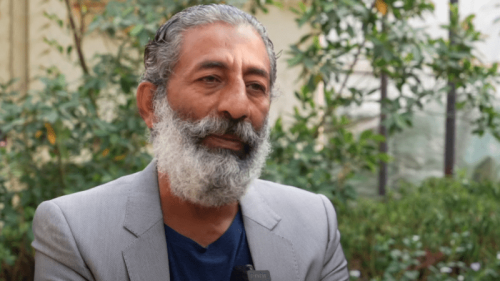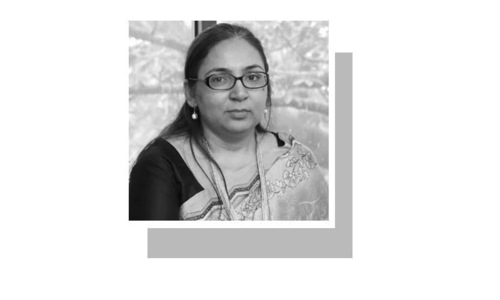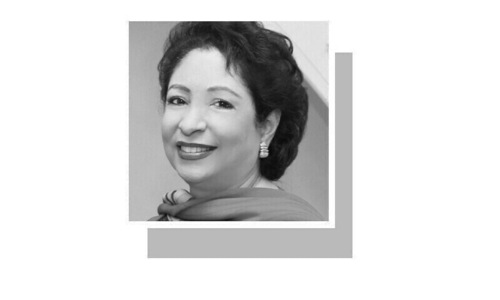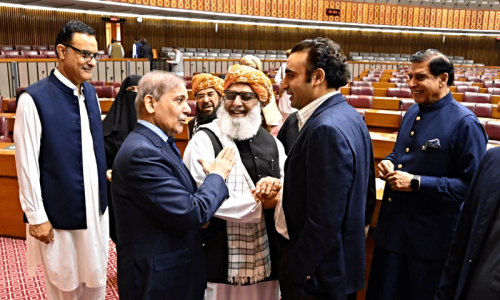FAST forward to the year 2071 to a Pakistan free from terrorism, crime … and human emotions, just a hellish dystopia where you have to smile to survive.
Welcome to Shehr e Tabassum — the first of its kind animated Urdu short-film set in a dystopian future, inspired by cyberpunk classics like Blade Runner and Akira as well as classic novels such as George Orwell’s 1984.
The trailer, which was released last week, is chilling — neon colours, flying rickshaws, digital screens everywhere, space suits, constant surveillance along with a robotic narrator explaining how the country has become the “happiest nation in the world” as it enjoyed three decades without cruelty, terrorism, depression and crime.
For many viewers, the trailer was also reminiscent of films and comics such as Persepolis and Watchmen.
Talking to Dawn, film director Arafat Mazhar said: “The film is located in a dystopian Pakistan where freedom of expression has been repressed entirely in the name of social order, stability and peace. This is done through the passing of an ordinance that criminalises all forms of expressions except smiling.
“Consider this: what if I were to say that if you see present-day Pakistan, you would see the some similar fundamental values which underlie the dystopian Pakistan of 2071? Would people be able to link the path we are on today to the future dystopia that is being presented? Would people be able to make the connections and see that the short-film, despite futuristic settings, essentially relates to contemporary questions and cultural anxieties or political realities? What happens if “monitoring frameworks” get out of hand and gain excessive usage, infringing our rights and liberties?
“What if the ideas of surveillance, offence and persecution were taken further and subjected to technology? In light of these questions and if you really see it this way, then the short-film actually has its foundation in the current socio-political climate and how it could end up looking like. Signs already exist today in the case of surveillance companies collaborating with the government to monitor citizens, ostensibly for purposes of security, but also for suppressing and persecuting free speech.”
Mr Mazhar, who is a musician, visual artist and an academic, is also the co-founder and director of Engage, a research institute that takes an interdisciplinary approach towards problematic citizenship discourses in Pakistan, further explained that dystopia is a solid genre to present situations and conditions which are familiar and ordinary or relatable, but also alien enough to seem distant and strange.
“The city of Shehr e Tabassum is stifling, creating a feeling of fear and anxiety since the viewer can discern a reflection of the familiar in the fictional future. And the conflict that Shehr e Tabassum encapsulates is between peace and rights: what is the cost of giving up your freedom or your rights for social order and stability? We hope that the short-film opens up space for this conversation to take place,” he said.
The concept for a short-film, according to Mr Mazhar, came from Ayesha Iftikhar, a prominent psychologist and co-founder of Shehri Pakistan.
“She came up with the concept of the short-film. Later, I began to thoroughly work through the idea with details of motivations and back stories. Bridging the distance between the present and the year the short film is based in greatly helped me comprehend the world that could be created,” he said.
“The idea was pitched to my team at Shehri Pakistan, who, by the way, had already been engaged, since long, in the creation of videos and animations for accessible civic education in local languages. And so, as things turned out, Isma Gul Hassan was given the role of the creative director for this short-film. From the overall colour palette, the gear worn by people in the teaser, the construction of Shehr e Tabassum as a city, to the design of the bots and the “mech” — these visual choices and decisions are all attributed to Isma.
“But once word began to spread that the first cyberpunk Urdu animated film in Pakistan was in the works at our organisation, several exceptionally talented individuals from diverse backgrounds were steered towards us. In Haseeb Rehman, who has been animating since his childhood by using flip books, we were lucky to locate a great character animator. Similarly, dozens of Urdu cyberpunk fonts were crafted by Shumyle Haider to lend the dystopian world its distinctly edgy and vibrant character. Equally important were contributions of Zahra Aamer, who assisted with the animations and also produced some of the ads you see in the teaser.”
While an official release date has not been announced yet, Mr Mazhar said the film would be out soon.
Published in Dawn, February 14th, 2019














































